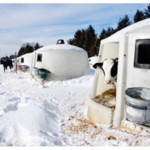Cold Weather Considerations For Calves
Click here to view as a pdf: Cold Weather Considerations For Calves
When temperatures start to drop, calf raisers need to make accommodations to ensure calves have the resources necessary to maintain their body temperature, support basic bodily functions and develop into productive, profitable, young stock. Two general areas to consider when preparing your calves for winter months are diet/nutrition and housing.
It is important to follow a consistent newborn calf protocol. Calves should be born in a clean, dry, well bedded calving pen. Newborns should be dried off and have their navels dipped within two hours of birth whenever possible. A 4-quart feeding of colostrum with a minimum Brix reading of 23% (or minimum of 200 IgG) should be fed within the first 4 hours of birth1. Calves can be fitted with a calf jacket at this time and monitored for any sign of difficulty with feeding.
Diet/Nutrition
Calves need calories to grow. A calf’s normal body temperature is 100.0-102.5°F and their (environmental) thermoneutral zone is between 50-78°F2. For every 10°F drop in temperature below a calf’s thermoneutral zone, their calorie needs increase by 10%2. As more energy is being used to maintain body temperature, less energy is available for other areas such as immune support and growth.
While fat additives, or increasing the fat percentage in the milk replacer, does increase calories delivered to the calf, research has shown this strategy is not the best approach as it can reduce the calves’ overall digestion efficacy3. Feeding increased fat to calves in the winter will sacrifice calf performance. It is for this reason that Crystal Creek® recommends increasing the amount of milk, or milk replacer, fed rather than increasing fat content. Crystal Creek® Swift Start® cold processed milk replacer provides easily digested fats for more useable energy, as well as wheat isolates to help with rumination and 100% organic trace minerals and selenium that support immune function.
It is important to be consistent with milk feeding times, volumes, temperatures and total solid concentrations. Total solid values need to remain between 12-14% to prevent nutritional scours4. Adding more powder but not increasing the amount of water mixed with it will change the total solids concentration and can cause nutritional scours.
Water intake helps with hydration and supports body functions, but it also drives calf starter/feed intake to help promote rumen development. The additional calories from calf starter can help calves meet energy requirements while providing heat from rumination to help warm the body. Offering warm water three times/day for a minimum of 30 minutes can encourage water consumption5. Feeding Crystal Creek® Swift Start® Texturized Calf Feed will provide quality protein sources to assist in digestibility and amino acids to support muscular/skeletal development while promoting daily rates of gain.
Housing/Ventilation
The main goal of any calf operation is to provide a clean, dry and comfortable environment for the calf. Whether housed in hutches or barns, calves will need adequate bedding and proper ventilation. A good rule of thumb is to provide 25 lb. of fresh, clean, long stem straw per 1,000 lb. of body weight every day6. Calves should be able to nest down in the bedding, so their legs are not visible. Wheat straw is the preferred bedding substrate for calves in the winter.
Calves in hutches should have hutch openings face away from the wind while allowing the calf to lie where it can benefit from the sun. Hutch vents should provide adequate air circulation but not create drafts. Calves in barns need a ventilation system that provides a fresh air exchange even in cold weather. Proper ventilation should assist in the removal of noxious gasses, moisture and irritant particles from the air. Do not close-up calf facilities to try to limit cold air exposure. This, in fact, reduces the VOLUME of fresh air supplied to calves and increases the risk of environmental pneumonia through contaminated air.
Keeping calves warm, healthy and growing during cold winter months is possible with the right strategy. Contact Crystal Creek® today to learn more.
SOURCES:
1) Cornell University, “Colostrum Collection and Handling, Usage of Refractometer” Retrieved from https://www.vet.cornell.edu/animal-health-diagnostic-center/programs/nyschap/modules-documents/ColostrumCollection
2) Dairy Herd Management, “Energize Your Calves This Winter”, (January 17, 2011), Retrieved from www.dairyherd.com/article/energize-your-calves-winter
3) Keunen, Aaron J., (June, 2018), “Performance effects of feeding Holstein calves a whole milk formulated milk replacer”, and Journal of Dairy Science, (Vol. 92, No. 10, 2009), “Effects of Fat Concentration of a High-Protein Milk Replacer on Calf Performance”.
4) WVDL, “Low Temperatures and Negative Energy Balance in Calves”, Retrieved from https://www.wvdl.wisc.edu/index.php/calf-maintenance-in-cold-weather/
5) Penn State Extension, “Calf Management Tips for Cold Weather”, Retrieved from https://extension.psu.edu/calf-management-tips-for-cold-weather
6) University Wisconsin-Madison School of Veterinary Medicine, Dairyland Initiative, Retrieved from https://thedairylandinitiative.vetmed.wisc.edu/home/housing-module/adult-cow-housing/bedded-pack/

